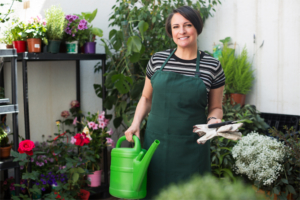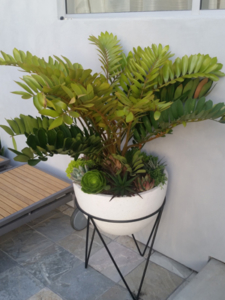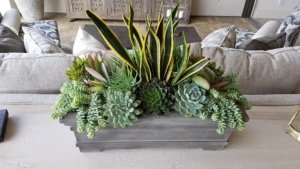Interiorscape Basics
Chapter Five: Watering Guide
The question to ask yourself as you approach each plant in your care is, “How much water should I add?” Each plant is unique due to a wide variety of circumstances. To ensure happy, healthy plants there are many considerations such as pot size, age, media and environment. You will need to determine the correct answer to the question of how much water using your senses, knowledge, moisture meter or soil probe. The following guidelines apply whether you use subirrigation or surface watering.

Before you water your plants, look at all the variables
Pot Size
This is the easiest one to control. Keep your plants in pots as small as possible. Let the roots grow to maximum capacity within the container, helping the plants to dry out adequately between watering. This does not mean never repot or never add soil. It just means repot when the plants are getting very tight in their shoes, not before.
It is best is to let plants dry down just “to the point of wilting” which lessens the danger of overwatering and encourages a healthy, faster growing plant. If you water a plant all the way through and it dries out beyond the point of wilting before your next visit, it needs more soil or a bigger pot.
How Much Water?

How much light does your plant receive?
If a plant, other than a cactus or a ponytail palm, is stationed in a sunny, bright window, it will probably need water added with every visit. Sometimes the plant will require a good soaking with water coming through to the saucer. Other times it will require less. Plants in high light are easier to water, for they are generally healthier and can survive overwatering better. They are more forgiving of our errors in judgment.
In minimum light, other conditions prevail. Minimum light maintenance is more demanding than high-light maintenance. Splash and dash maintenance does not work here. Success of a minimum light plant depends on your skills and knowledge plus the health of the plant when it was installed. When you approach a plant in minimal light, use all your senses to read its signals. Look at its leaves. Is green new growth dropping? Smell the soil. Does it smell sour? Reach your hand down and feel in the saucer. Is it moist? These are all signs of too much water.
Think Before You Pour
To learn how to water correctly and successfully, a lot of information must go through your mind automatically. With hundreds of plants in your care this information needs to course through your mind for each individual plant. If a plant has not used the water you expected it to, you might need to pause and rethink how you might water this week considering current conditions and new information.
Five Alive Checklist
1. Light
- How bright or dark was it during this last week?
- Were the shades drawn?
- Was the sun beating down on the plant?
- Was the plant in a conference room that didn’t get used and no one turned on the lights?
- Did it get the regular amount of light? Be observant. The ongoing light level is a huge key to determining water use. Remember: more light = more water.

How can you tell if your plants need water?
2. Foliage
- Are the leaves drooping or upright?
- How do the tips of the leaves look…yellow? brown?
- Are there bright yellow leaves?
- Are you observing warm, limp, leaves with bright yellow foliage and thinking too much water?
- Are you considering overwatering when you see limp, blotchy, yellowish/green foliage?
- Does the plant have mites? (Plants with a mite infestation tend to slow their water intake.)
3. Soil
- Is the soil soggy wet below the top two inches?
- How does it smell?
- Did someone just dump their leftover coffee in it?
- What kind of soil is the plant growing in?
- Did you misjudge how much water last week?
4. Roots
- How are the roots? The more roots that fill the container, the more water the plant will use.
- Tug gently on the stems. Do they seem secure or does the plant give with that pull? A plant with a small or damaged root system will move when pulled on. An under-rooted plant needs to be watered with extra care, and should be given less water than a well-rooted plant. As healthy plants grow, they will establish additional roots that will eventually fill the container and more roots will require a bit more water to saturate fully.
5. Old Age
- How long has the plant been in the account?
- Was the plant recently moved? Older plants in low light need less water than new plants in low light. As a plant acclimates to its interior environment, its water needs change. Plants in high light will increase their water needs as the plants grow and thrive in their ideal setting. You have to keep a mental inventory of about how long the plant has been in its location. Learn to notice the subtle signs of water stress in plants. Plants with proper moisture will have firm, turgid foliage. Leaves will feel cool to the touch and be oriented toward the light source. Plants lacking sufficient moisture feel limp and warm to the touch as the foliage starts to droop. Using techniques such as finger check, moisture meter or soil probe, and container weight help determine the proper amount of water.
Use your Finger
Many interiorscapers use their finger to judge soil moisture. This may work with small plants, but becomes increasingly more difficult when the container is large and the plant more pot bound. The target depth where you want to judge moisture is at least one third of the way down in the container—how long is your finger? Also consider what might be hiding in that soil; systemic pesticides and other gross trash may be lurking.
Judge by Weight
Learn to judge the moisture content by the weight of the plant. This works especially well for color units, hanging baskets and smaller containers. It is not a reliable method in larger plants, as they are too heavy to lift for inspection purposes. Lift plants on a weekly basis, noting how the weight changes as the media dries out. By making the connection between weight and moisture this method can be used to figure out watering needs.
** Tidbit **
Using a Meter or Probe Properly
- Check your meter regularly for accuracy. Put the meter’s probe in a bucket of tap water. If the needle immediately goes to the highest reading it is still in working order. Meters do wear out, so if the reading is only part way up the scale, you know it is time for a new meter.
- Gently push or wiggle your meter or probe through the media, especially if the media is cinder soil so as not to damage the tip.
- Do not worry about damaging the roots if the meter or probe is difficult to push into the media. Think of it as aerating the soil and letting more oxygen into the roots.
- Insert the meter or probe at two or three different locations to help you determine if all areas of the root ball are getting water. Note the moisture levels at different depths, as well.
- Leave the meter in the soil as you add water so you can see the water travel through the soil as the gauge moves upward.
- The tip of the meter generates a very small current of electricity when it touches the salts in the water. If you are using water that is alkaline or testing a plant you suspect has a high salts content, you might not get an accurate reading.
- Sterilize meters and probes used in pots infected with stem or root rots to prevent the spread of microorganisms.
Moisture Meter or Soil Probe
Insert the probe into the soil to the active root zone of the plant and analyze the results on the gauge. Usually, this means two-thirds of the way down into a small pot or six to eight inches in a large pot.
A benefit to using meters is you can be assured that everyone within your company will be speaking the same language regarding soil moisture. A reading of “3” on a meter can only mean one thing (3 = slightly moist). When using your finger as the gauge what feels slightly moist to one person may mean wet to another.
Combine and Conquer
It is best to not depend on one method for watering all plants. Learn to use a variety of methods for different plant situations. By using a combination of the above methods along with your knowledge of plants, you too can be a water wizard.
